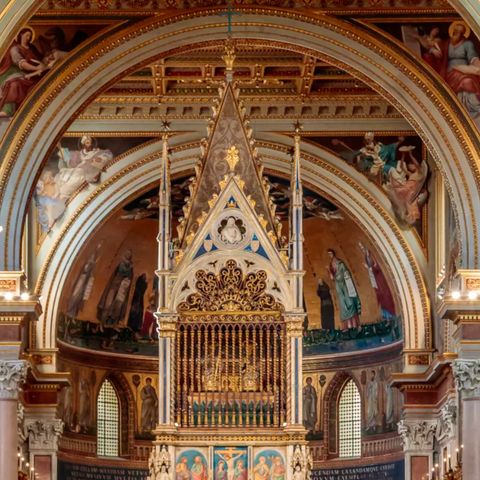November 9: Dedication of the Lateran Basilica

Descarga y escucha en cualquier lugar
Descarga tus episodios favoritos y disfrútalos, ¡dondequiera que estés! Regístrate o inicia sesión ahora para acceder a la escucha sin conexión.
Descripción
November 9: Dedication of the Lateran Basilica Feast; Liturgical Color: White A venerable basilica is the mother of all churches In the eighth chapter of his Confessions, Saint Augustine relates...
mostra másFeast; Liturgical Color: White
A venerable basilica is the mother of all churches
In the eighth chapter of his Confessions, Saint Augustine relates the story of an old and learned Roman philosopher named Victorinus. He had been the teacher of many a Roman senator and nobleman and was so esteemed that a statue of him was erected in the Roman Forum. As a venerable pagan, Victorinus had thundered for decades about the monster gods, dark idols, and breathless demons in the pantheon of paganism. But Victorinus assiduously studied Christian texts and whispered to a friend one day, “You must know that I am a Christian.” The friend responded, “I shall not believe it…until I see you in the Church of Christ.” Victorinus responded mockingly, “Is it then the walls that make Christians?” But in his grey hairs, Victorinus finally did pass through the doors of a Catholic church to humbly bow his head to receive the waters of Holy Baptism. There was no one who did not know Victorinus, and at his conversion, Augustine writes, “Rome marveled and the Church rejoiced.”
A church’s walls do not make one a Christian, of course. But a church has walls nonetheless. Walls, borders, and lines delimit the sacred from the profane. A house makes a family feel like one, a sacred place where parents and children merge into a household. A church structurally embodies supernatural mysteries. A church is a sacred space where sacred actions make Christians unite as God’s family. Walls matter. Churches matter. Sacred spaces matter. Today the Church commemorates a uniquely sacred space, the oldest of the four major basilicas in the city of Rome. The Lateran Basilica is the Cathedral of the Archdiocese of Rome and thus the seat of the Pope as Bishop of Rome.
A basilica is like a church which has been made a monsignor. Basilicas have certain spiritual, historical, or architectural features by which they earn their special designation. Considered only architecturally, a basilica is a large, rectangular, multi-naved hall built for public gatherings. When Christianity was legalized, its faithful spilled out of their crowded house churches and into the biggest spaces then available, the basilicas of the Roman Empire. If Christians had met in arenas, then that word would have been adopted for ecclesial usage instead of basilica.
The Laterani were an ancient Roman noble family whose members served several Roman Emperors. The family built a palace carrying their name on a site which in the fourth century came into the possession of the Emperor Constantine, who then turned it over to the bishop of Rome. An early pope enhanced and enlarged the basilica style palace into a large church, which, in turn, became the oldest and most important papal church in the eternal city. The popes also began to personally reside in the renovated Lateran palace. By medieval times, the Basilica was rededicated to Christ the Savior, Saint John the Baptist, and Saint John the Evangelist. The popes lived at the Lateran until the start of the Avignon papacy in present day France in 1309.
With the Avignon papacy ensconced far from Rome for seven decades, the Lateran Basilica was damaged by fires and deteriorated so sadly that by the time the popes returned to Rome in 1377, they found the Basilica inadequate. An apostolic palace was eventually built next to St. Peter’s Basilica on the Vatican hill and has been the seat of the successors of Saint Peter ever since. The Lateran Basilica retains its venerable grandeur, despite now being a baroque edifice with only a few architectural traces of its ancient pedigree. Beautiful churches are like precious heirlooms passed down from one generation to the next in God’s family. Walls do not make us Christians, but walls do clarify that certain sacred rituals are practiced in certain sacred spaces and in no others. A family in its home. A judge in his court. A surgeon in her operating room. An actor on his stage. God on His altar. We come to God to show Him the respect He deserves. He is everywhere, yes, but He is not the same everywhere. And we are not the same everywhere either. We stand taller and straighter when we step onto His holy terrain.
Heavenly Father, we praise You more worthily when we are surrounded by the holy images in Your holy churches. Through Your grace, inspire us to render You due homage in the houses of God where Your presence burns brighter and hotter than anywhere else.
Información
| Autor | Fr. Michael Black |
| Organización | Michael Black |
| Página web | - |
| Etiquetas |
Copyright 2024 - Spreaker Inc. an iHeartMedia Company
